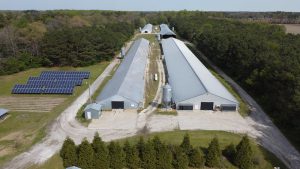
An innovative, partnership-led ambient air quality monitoring project in Maryland has recorded more than two years of data about ammonia and particulate matter air emissions on the Eastern Shore, and has shown little variation in average air pollution levels between areas with no chicken farms, areas with a low density of poultry farms, and areas with many poultry farms.
The Lower Eastern Shore Air Monitoring Project, overseen by the Maryland Department of the Environment (MDE), began collecting continuous data about ammonia, fine particulate matter (PM 2.5), and coarse particulate matter (PM 10) in April 2020 at locations in Princess Anne (designated a low poultry operation density site), Pocomoke City (designated a high poultry operation density site), and an urban Maryland location not on the Eastern Shore with no nearby poultry operations. Delmarva Chicken Association (DCA) and the Keith Campbell Foundation for the Environment jointly supported the effort with more than $500,000 in funds. MDE, along with the University of Maryland Eastern Shore is responsible for collecting and publishing the data gathered by the ongoing project.
The data for the life of the project to date shows average ammonia (NH3) levels for the urban site to be at 1.6 percent of a MDE-designated 350 parts per billion concern threshold; 1.3 percent of the threshold level in Princess Anne (lower than in the urban area); and 2.9 percent of the threshold in Pocomoke City.

The Pocomoke City site, with a high density of poultry operations, saw lower maximum hourly values for each pollutant than the Princess Anne site, with a comparatively lower density of nearby poultry farms. Days when relatively maximum hourly values were recorded in Princess Anne, the low poultry operation density site, coincide with days when commercial fertilizer (which contains nitrogen, the solid form of ammonia) was applied to cropland in the area around the monitoring site. None of the recorded ammonia hourly value spikes at any site have exceeded the 350 parts per billion concern threshold, and the values recorded by MDE during the Lower Eastern Shore Air Monitoring Project are consistent with values recorded throughout the state.
“The nearly 30 months of data recorded and published by the Lower Eastern Shore Air Monitoring Project are valuable to researchers and the public,” said Holly Porter, DCA’s executive director. “We in the chicken community have a shared interest with all Marylanders in better understanding what air quality is truly like on the Eastern Shore and elsewhere in the state.”
Delmarva Chicken Association, founded in 1948, is the Delmarva chicken industry’s voice as the premier membership association focusing on advocacy, education and member relations. For more information, visit dcachicken.com; like DCA on Facebook; and follow us on Twitter and YouTube.
Contact: James Fisher, communications manager, 302-856-9037 (work) or 302-500-2223 (cell).





